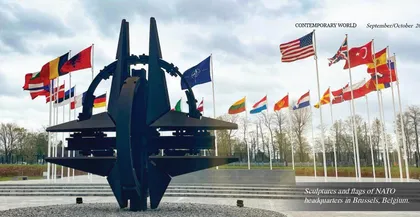Global NATO Pivots to Asia-Pacific and Prospect
作者: Jin Ling

In recent years as the strategic focus of the U.S. pivots, the focus of NATO’s action on crisis management have been gradually shifted to superpower games. Its geopolitical priorities have also pivoted to the Asia-Pacific region. Comprehensive crisis management gives way to the enhancement of military containment capacity. However, NATO’s security threats happen to come from its interior, since the values it advocates including the so-called human rights, democracy and the rule of law are being undermined from within. Under the hegemonic logic, the U.S. cannot bring peace or security through either active interventionism that was once executed by force or building exclusive alliances today by tying its allies to its chariot.
GLOBAL NATO SERVES THE LOGIC OF PRESERVING POST-COLD WAR U.S. HEGEMONY
Since the establishment of NATO’s so-called “global partnership”, the concept, scope and action priorities of the Global NATO have been constantly adjusted from the initial aim of exporting the Western model to the world through crisis management, conflict prevention and nation building to today’s pivot to the Asia-Pacific region, which serves the U.S. strategic goal of superpower games. The evolution of Global NATO is closely related to the international environment and reflects the strategic intention of the U.S. to maintain its hegemony.
In 1999, NATO’s Strategic Concept put forward its security objectives of strengthening the alliance for the first time, in which crisis management beyond NATO’s borders and partnership played an important role. It can be regarded as the embryo of the Global NATO. Since the 21st century, the Global NATO has gradually taken shape as the alliance expands its reach. Starting with NATO’s take over of the International Security Assistance Force (ISAF) in Afghanistan in 2003, its operations has become worldwide, covering a wide range of military and civil fields. In 2005, Jaap de Hoop Scheffer, the then Secretary General of NATO, made his point that since the NATO has already set its foot outside the region, it needs to strengthen cooperation with other countries that are interested, and should establish an alliance with global partners.
Against this background, the Riga Summit in 2006 marked a watershed for NATO going global. The U.S. and the UK jointly proposed to build a global partnership for a platform to expanding the dialogue between NATO and other democratic countries. Later, NATO’s Strategic Concept 2010 highlighted the importance of crisis management and partnership, pointing out that crises and conflicts beyond NATO could pose a direct threat to the territory and security of the alliance. NATO should participate in crisis prevention and management as well as post-conflict stability support and reconstruction where possible and when necessary.
In the two decades after the Cold War, NATO has transformed from a regional collective security organization to a global political and security institution. Its traditional defense and containment capacity has given way to crisis management capability. Its network has also broken through the traditional alliance framework and it has sought to build a global partnership network that extends far beyond the Euro-Atlantic region to the surrounding areas and spreads to the Asia-Pacific region. NATO’s global transformation reflects its efforts in seeking legitimacy after the Cold War, and the fundamental characteristics of serving the needs of the U.S. to maintain its hegemony. NATO’s transformation from a military organization to a political military organization and its emphasis on common values as well as the role of conflict prevention and nation building in crisis management, are all in line with U.S. concept of maintaining hegemony. From a practical perspective, the consistency of NATO’s transformation and its mission to serve U.S. hegemony is clearly demonstrated either in the decrease of NATO’s crisis management actions beyond its borders, or expansion of NATO’s anti-terrorism operations in Afghanistan to a process of nation building, which eventually came to an end with the “Fall of Kabul” in 2021.
PROCESS AND CAUSE OF GLOBAL NATO PIVOTING TO ASIA-PACIFIC
Since Obama’s strategic pivot eastward, the U.S. has increasingly shifted its global strategic focus to the Asia-Pacific region, a profile that has been clearly revealed in NATO’s transformation in recent years. The latest NATO Strategic Concept 2022 points out that the situation in the Indo-Pacific region directly affects the Euro-Atlantic security, and that NATO will strengthen dialogue and cooperation with both new and existing regional partners to address cross-regional challenges and bind their security interests.
The role of Asia-Pacific countries as NATO’s global partners is ascending. Dialogues and cooperation between NATO and Japan dates back to 1990. New Zealand established dialogue and cooperation with NATO in 2001, and South Korea and Australia in 2005. NATO has significantly strengthened its political contacts with the four partners in Asia-Pacific region since 2016. In December 2016, NATO held its first formal meeting with the four Asia-Pacific countries in Brussels, which institutionalized their cooperation. In December 2020, the foreign ministers of the four countries participated in the NATO Foreign Ministers’ Meeting for the first time to discuss the changes in the global balance of power and the rise of China. In May 2022, NATO Military Committee invited the defense ministers of Australia, Japan, South Korea and New Zealand to its Chiefs of Defence conference. In June, with the goal of working more closely with like-minded countries in an era of strategic competition, NATO members invited Japan, South Korea, Australia and New Zealand to the NATO summit for the first time.